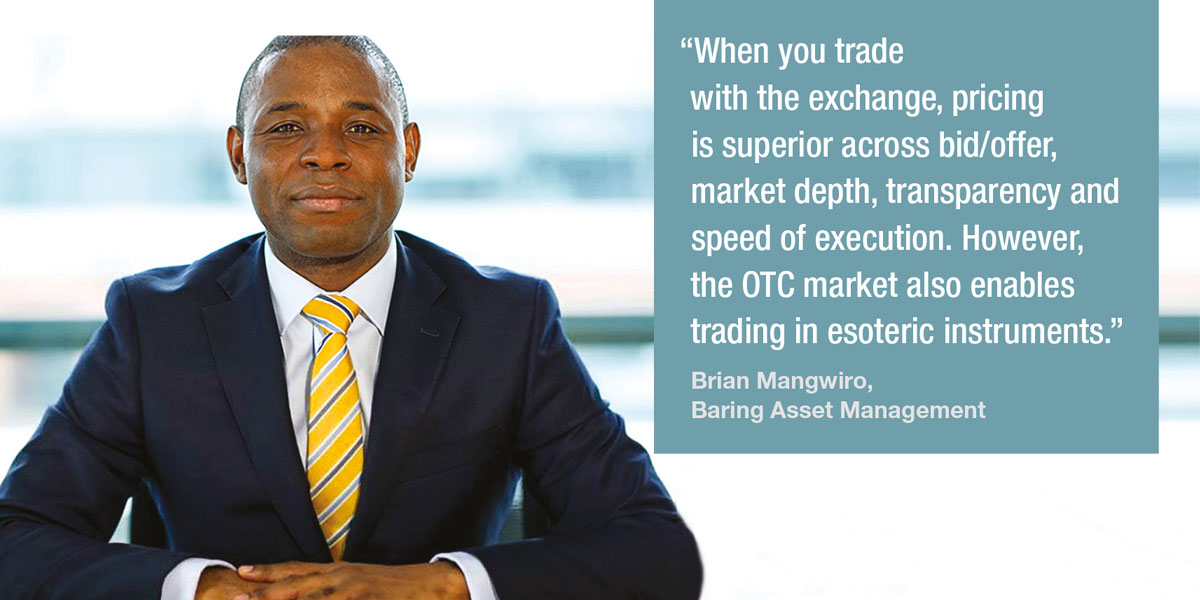
Investment managers looking for better access to credit derivatives see next year as an opportunity to test new products. The DESK speaks to David Litchfield, director, derivatives sales at Cboe Global Markets and Dr Brian Mangwiro, multi-asset portfolio manager at Baring Asset Management.
How is the appetite for credit derivatives developing across the buy side this year?
David Litchfield: The range of derivatives in the credit space is limited. Broadly speaking, there are credit default swaps (CDS), options and indices like CDX and iTraxx. And there are OTC total return swaps (TRS), although there is a question whether TRS will grow beyond this stage as uncleared margin rules (UMR) continues to phase in. And you can hedge duration by trading futures on government bonds like US Treasuries and German Bunds.
Futures are established in almost every single market but the corporate bond market. In the credit space, the advantage of futures is that they are listed, centrally cleared, and provide access to all-to-all liquidity. We are seeing more client-to-client transactions in addition to those with liquidity providers, which offer a diversity of flow. It’s also not just fundamental managers. There are very different users which mean that the diversity of liquidity is healthy with fast money and real money both longs and shorts.
Brian Mangwiro: Traditionally buy side firms have been long-only businesses. Their use of derivatives has been predominantly on a hedging basis. But with interest rates falling to extreme lows and spreads continuing to tighten, the pressure to generate attractive returns is pushing some managers to consider [modestly] leveraged portfolios. Consequently, the use of derivatives is increasing, albeit while remaining largely conservative as most clients tend to prefer low risk strategies.
How would you characterise the level of preparedness to use credit derivatives among traditional long-only asset managers?
David Litchfield: Engagement is pretty strong, notwithstanding the fact that these futures are brand new. Therefore, clients need to learn these products are available before conversations turn to what they are and how they work. Multi-asset accounts are typically the most engaged because they are accustomed to trading futures across multiple different asset classes.

Brian Mangwiro: We run a mix of benchmarked and absolute return strategies. In interest rates we use futures, options on futures, swaps and options on swaps to express directional and relative value investment views. In credit we use CDS/CDX and futures to leverage, and sometimes to hedge portfolios. For currencies, we use swaps, forwards, futures and options (on futures and forwards) to hedge currency risk in bond portfolios or generate excess returns.
Credit strategies invest in corporate and EM hard currency bond spreads. We therefore hedge out interest rate risk via selling interest rate futures, predominantly in US and German Bunds, for USD and EUR rates, respectively. Absolute return mandates also use futures, swaps (include CDS/CDX) and options to express directional or relative value investment views for alpha generation.
David Litchfield: Fundamental long-only credit managers typically have a longer adoption process for two reasons. Firstly, using a listed instrument is out of their normal purview as their realm is typically OTC, cash bond and derivatives trading. Secondly, introducing a listed instrument can be problematic from a mandate perspective as well as getting past the learning curve. That said, the client interest we are seeing is significant. Among the asset owner community, the utility of futures is clear. The majority use government bond futures – which fit their mandate – so they know how futures work. The corporate bond futures that we offer aren’t too much of a leap for them to start using. It’s just a question of going through the approval process.
Another issue out there is perceived liquidity. A large number of clients wait on the side-lines for more liquidity to come to market, to ensure they can trade at size. However, there is a misconception if they think the size is not there; they will look on the screen and see the volumes as they are now, but so far two banks are supplying block prices in addition to other market makers. That is a big game changer.
What difference does that make to liquidity?
David Litchfield: A lot of institutions will require at least two or three banks to be put into competition for best execution. With two banks supporting the products, it is very encouraging. Other banks are looking to set up sooner rather than later as well. If a desk needs to trade US$100 million but only sees an open interest of US$100 million that might be a perceived barrier. But if they are used to trading US$100 million dollars of HYG or LQD by phoning a bank and asking for a risk price, they can do the same thing in the futures and find comfort in the liquidity that it brings.
Do you think that the increased use of exchange traded funds in the fixed income space is changing the perception of using listed instruments as part of a credit portfolio?
David Litchfield: Yes, a lot of credit accounts are getting over that by overcoming two hurdles. One is that credit ETFs are an equity security even though they hold corporate bonds. Investment managers have had to set up ETFs as an acceptable instrument, whereas futures are typically written into most investment mandates. The second is that some fundamental credit investors have been reticent about using a passive instrument, because their role is to pick bonds. However, it’s not the case that a manager picking US equities isn’t ever going to own long or short S&P 500 futures, they are using it for different reasons. A manager managing US equities isn’t just going to buy S&P futures and sit on them as their whole portfolio construction. Now that groundwork with the ETFs has been done, the step into futures isn’t so problematic, in terms of the use of Beta.
Brian Mangwiro: I would add that when you trade with the exchange, pricing is superior across bid/offer, market depth, transparency and speed of execution. However, the OTC market also enables trading in esoteric instruments which is not feasible on an exchange. For example, while bond futures are limited to vanilla 2-, 5-, 10- and 30-yr tenor points, swaps enable us to trade in numerous permutations and combinations such as receiving 3-yr rates, 5-yr forward or buying a put swaption on 10-yr rates, 30-yr forward. That ability to customise trades is a significant advantage.
Next year we see further progress on Uncleared Margin Rules, how is that driving change?
David Litchfield: If investment managers are currently getting exposure via uncleared derivatives, they will need to be running through the maths, talking to partners, prime brokers and assessing what today’s margin requirements are and what they will become in September, when Phase 6 comes into force for a lot of managers. When they are looking at their credit trading and investment process, they need to put futures on the table to compare the margin processes and requirements across all the instruments. The OCC currently requires <5% initial margin for the iBoxx futures.
In addition to the iBoxx futures, what is Cboe doing next year?
David Litchfield: We are looking to launch options on futures next year. We believe these will offer tremendous utility to the market as a whole. There are currently options on ETFs, which are physically settled. The issue is, many mandates don’t want to hold the physical ETFs if they are hedging bonds, and nor do volatility funds. They want cash settlement. In addition, because those options are on 1940 Act ETFs, they typically exclude UCITS and other European mandates from using them, meaning pretty much the whole European market is shut out. So, on the options side there is a huge demand for options on futures. We are also looking to launch other exposures, as we have received demand for Euro, high yield and investment grade, and emerging markets hard currency.
©Markets Media Europe 2021
©Markets Media Europe 2025






















